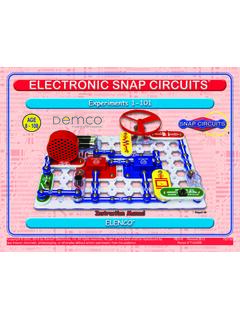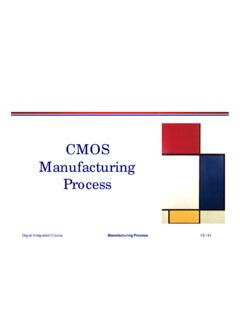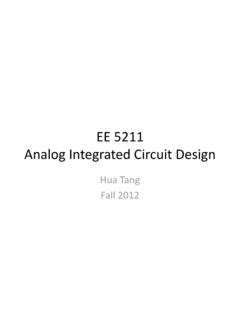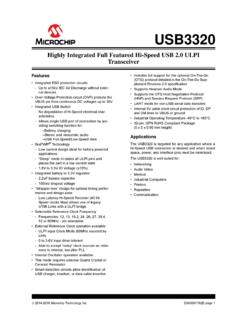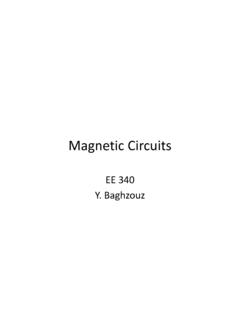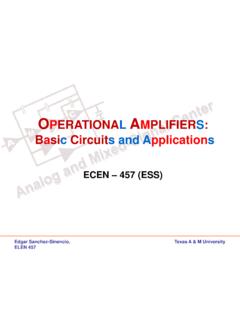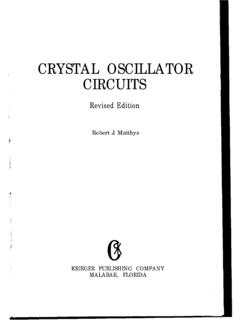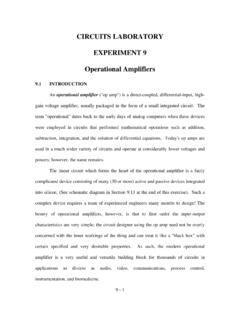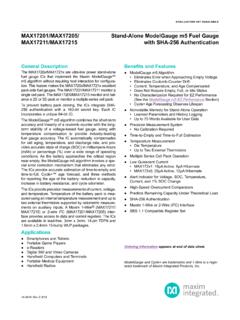Transcription of Laboratory Manual for DC Electrical Circuits
1 DC Electrical CircuitsDC Electrical CircuitsLaboratory ManualLaboratory ManualJames M. FioreJames M. Fiore Laboratory Manual for DC Electrical Circuits2 Laboratory Manual forDC Electrical CircuitsbyJames M. FioreVersion , 13 November 2017 Laboratory Manual for DC Electrical Circuits3 This Laboratory Manual for DC Electrical Circuits , by James M. Fiore is copyrighted under the terms of a Creative Commons license: This work is freely redistributable for non-commercial use, share-alike with attributionPublished by James M. Fiore via dissidents For more information or feedback, contact:James Fiore, ProfessorElectrical Engineering TechnologyMohawk Valley Community College1101 Sherman DriveUtica, NY via art, Vibralt II, by the author Laboratory Manual for DC Electrical Circuits4 IntroductionThis Manual is intended for use in a DC Electrical Circuits course and is appropriate for two and four year Electrical engineering technology curriculums.
2 The Manual contains sufficient exercises for a typical 15 week course using a two to three hour practicum period. The topics range from basic Laboratory procedures and resistor identification through series-parallel Circuits , mesh and nodal analysis, superposition, Thevenin s Theorem, Maximum Power Transfer Theorem, and concludes with an introduction to capacitors and inductors. For equipment, each lab station should include a dual adjustable DC power supply and a quality DMM capable of reading DC voltage, current and resistance. A selection of standard value watt carbon film resistors ranging from a few ohms to a few mega ohms is required along with 10 k and 100 k potentiometers.
3 1 F and .22 F capacitors, and 1 mH and 10 mH inductors. A decade resistance box may also be exercise begins with an Objective and a Theory Overview. The Equipment List follows with space provided for serial numbers and measured values of components. Schematics are presented next along with the step-by-step procedure. All data tables are grouped together, typically with columns for the theoretical and experimental results, along with a column for the percent deviations between them. Finally, a group of appropriate questions are presented. For those with longer scheduled lab times, a useful addition is to simulate the circuit (s) with a SPICE-based tool such as Multisim, PSpice, TINA-TI, LTspice, or similar software, and compare those results to the theoretical and experimental results as companion Manual for AC Electrical Circuits is also available.
4 Other manuals in this series include Semiconductor Devices (diodes, bipolar transistors and FETs), Operational Amplifiers & Linear integrated Circuits , Computer Programming with Python and Multisim , and Embedded Controllers Using C and Arduino. Texts are also available for Embedded Controllers, Op Amps & LIC, and Semiconductor Note from the AuthorThis work was borne out of the frustration of finding a lab Manual that covered all of the appropriate material at sufficient depth while remaining readable and affordable for the students. It is used at MohawkValley Community College in Utica, NY, for our ABET accredited AAS program in Electrical Engineering Technology.
5 I am indebted to my students, co-workers and the MVCC family for their support and encouragement of this project. While it would have been possible to seek a traditional publisher for this work, as a long-time supporter and contributor to freeware and shareware computer software, I have decided instead to release this using a Creative Commons non-commercial, share-alike license. I encourage others to make use of this Manual for their own work and to build upon it. If you do add to this effort, I would appreciate a notification. Begin with the possible and move gradually towards the impossible -Robert FrippLaboratory Manual for DC Electrical Circuits5 Laboratory Manual for DC Electrical Circuits6 Table of Electrical Sources and Color s DC DC DC and and venin s Power and A: Technical Report B: Example Technical C: Creating Graphs Using a Spreadsheet79 Appendix D.
6 Using a Solderless Manual for DC Electrical Circuits71 The Electrical LaboratoryObjectiveThe Laboratory emphasizes the practical, hands-on component of this course. It complements the theoretical material presented in lecture, and as such, is integral and indispensible to the mastery of the subject. There are several items of importance here including proper safety procedures, required tools, and Laboratory reports. This exercise will finish with an examination of scientific and engineering notation, the standard form of representing and manipulating Safety and ToolsIf proper procedures are followed, the Electrical lab is a perfectly safe place in which to work.
7 There are some basic rules: No food or drink is allowed in lab at any time. Liquids are of particular danger as they are ordinarily conductive. While the circuitry used in lab is normally of no shock hazard, some of the test equipment may have very high internal voltages that could be lethal (in excess of 10,000 volts). Spilling abottle of water or soda onto such equipment could leave the experimenter in the receiving end of a severe shock. Similarly, items such as books and jackets should not be left on top of the test equipment as it could cause lab bench is self contained.
8 All test equipment is arrayed along the top shelf. Beneath this shelf at the back of the work area is a power strip. All test equipment for this bench should be plugged into this strip. None of this equipment should be plugged into any other strip. This strip is controlled by a single circuit breaker which also controls the bench light. In the event of an emergency, all test equipment may be powered off through this one switch. Further, the benches are controlled by dedicated circuit breakers in the front of the lab. Next to this main power panel is an A/B/C class fire extinguisher suitable for Electrical fires.
9 Located at the rear of the lab is a safety kit. This contains bandages, cleaning swaps and the like for small cuts and the like. For serious injury, the Security Office will be lab bench should always be left in a secure mode. This means that the power to each piece of test equipment should be turned off, the bench itself should be turned off, all AC and DC power and signal sources should be turned down to zero, and all other equipment and components properly stowed with labstools pushed under the bench. Laboratory Manual for DC Electrical Circuits8It is important to come prepared to lab.
10 This includes the class text, the lab exercise for that day, class notebook, calculator, and hand tools. The tools include an electronic breadboard, test leads, wire strippers,and needle-nose pliers or hemostats. A small pencil soldering iron may also be useful. A basic DMM (digital multimeter) rounds out the list. A typical breadboard or protoboard is shown below:This particular unit features two main wiring sections with a common strip section down the center. Boards can be larger or smaller than this and may or may not have the mounting plate as shown.

